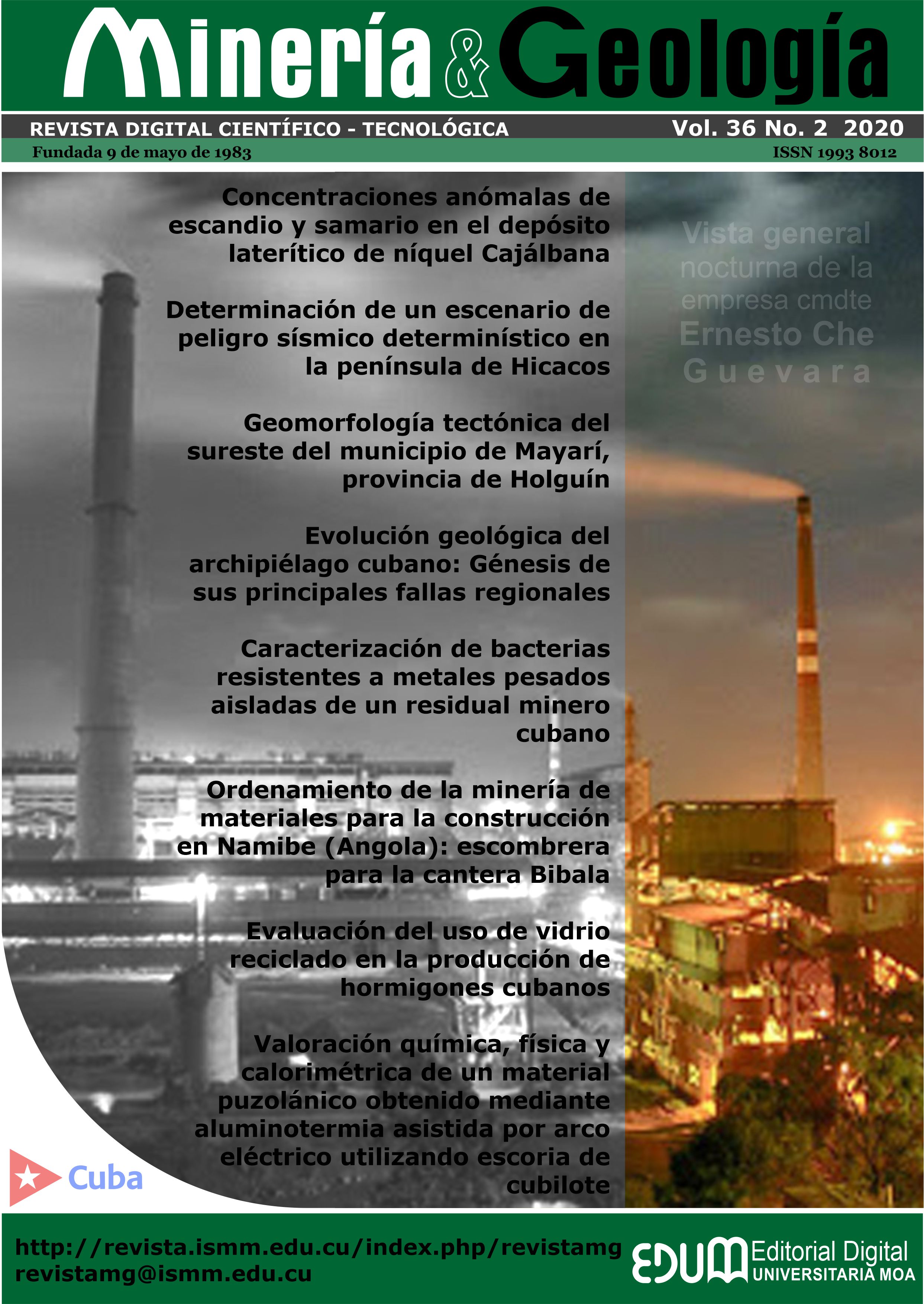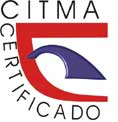Establishing a deterministic seismic hazard scenario at the Hicacos peninsula
Keywords:
deterministic seismic hazard, hazard scenario, peak acceleration, seismic source, soil response spectrum.Abstract
Using a deterministic approach to characterize soil movements, an earthquake scenario was developed for determining the seismic hazard of the Hicacos peninsula in Matanzas, Cuba. The earthquake origin areas of the western territory with the highest seismic potential, within a radius of 300 kilometers, were selected for the peninsula. Earthquakes with the maximum magnitude were associated in these faults based on expert judgment based on results of recent studies. On the basis of the description of geological characteristics of formations present on the peninsula, a classification of the soil type was made according to the current seismic standard (Cuban Standard, 2017).The earthquake data was processed by using SELENA software in conjunction with the empirical relationships for predicting soil movement and the distance to each site (soil unit) for the deterministic analysis of seismic hazard. As a result, soil response spectrum values (PGA, Sa0.2, Sa1.0) were obtained for both soft soil and rock-type soil according to the earthquake scenario and it was correlated intensity with soil movement parameters.Downloads
References
Abrahamson, N. A. y Silva, W. J. 2008: Summary of the Abrahamson and Silva NGA ground‐motion relations. Earthquake Spectra, 24(1): 67–97.
Álvarez, L.; Lindholm, C. y Villalón, M. 2017: Seismic hazard for Cuba: A new approach. Bull. Seismol. Soc. Am., 107(1): 229-239. Consulta: 15/12/2019. doi: 10.1785/0120160074.
Arango-Arias, E. D.; González-Matos, O. F.; Palau-Clares, R. y Leyva-Arias, M. 2017: Evaluación del comportamiento de la actividad sísmica de Corralillo, Villa Clara, Cuba iniciada el 9 de enero de 2014. Ciencias de la Tierra y el Espacio, 18(1): 71-85. ISSN 1729-3790.
Braunmiller, J.; Thompson, G. y McNutt, S. 2019: The January 2014 Northern Cuba Earthquake Sequence: Unusual location and unexpected source mechanism variability. Bulletin of the Seismological Society of America, 109(3): 919-928. Consulta: 15/12/2019. doi: 10.1785/0120180272.
Carrillo, D.; Echavarría, B.; Castellanos, E.; Triff, J. y Núñez, K. 2009: Léxico Estratigráfico de Cuba. La Habana: Instituto de Geología y Paleontología.
Chuy, T. J.; González, B. E. y Orbera, L. 1994: Seismicity and Seismic Hazard Assessment for Western Cuba. Minería y Geología, XI(3): 45-51.
Chuy, T. J. 1999: Macrosísmica de Cuba y su utilización en los estimados de Peligrosidad y Microzonación Sísmica. Tesis doctoral. Fondos del MES y del IGA. 150 p.
Chuy, T. J. y LLanes, C. 2012: Impacto en la región occidental de Cuba del terremoto de San Cristóbal de 1880. En: Salud y desastres. Experiencias cubanas. Tomo V. La Habana: Editorial Ciencias Médicas. ISBN 978-959-212-599-5.
Chuy, T. J.; Candebat, D.; Arango, E. D.; Arencibia, E.; González, O. F. y Leyva, M. 2017: Informe del sismo del 29 de julio de 2017 de Santa Marta –Varadero, provincia de Matanzas. Informe Técnico. Fondos del CENAIS. 25 p.
Chuy, T. J.; Candebat, D.; Arango, E. D.; Arencibia, E. E.; González, O. F. y Leyva, M. 2017: Informe del sismo del 29 de julio del 2017 de Santa Marta – Varadero, provincia de Matanzas. Fondos del CENAIS.
Cofiño, C. E. y Cáceres, D. 2007: Desciframiento de la evolución de estructuras tectónicas mediante la utilización de métodos microtectónicos (caso de estudio falla Pinar). En: 2da Convención Cubana de Ciencias de la Tierra, VII Congreso de Geología (GEOLOGIA´2007), Geología Regional y Tectónica.
Cofiño, C. E.; Fernández de Lara, R.; Ordaz, A. y Cáceres, D. 2011: Origen y funcionamiento de la estructura tectónica Pinar a partir de datos geólogo–geofísicos. En: 4ta Convención Cubana de Ciencias de la Tierra, X Congreso Cubano de Informática y Geociencias (GEOINFO'2011).
Comisión Sismológica Europea 1998: Escala Macrosísmica Europea (EMS-1998). 95 p.
Cotilla, M.; Bankwitz, P.; Franzke, H. J.; Álvarez, L.; González, E.; Diaz, J. L.; Grunthal, G.; Pilarski, J. y Arteaga, F. 1996: Una valoración sismotectónica de Cuba. Revista Geofísica, 45: 145-179.
Cotilla, M. O. 1998: An overview on the seismicity of Cuba. J. Seism., 2: 323–335.
Cotilla, M.; Bankwitz, P.; Franzke, H. J. y Cordoba, D. 2007: Seismicity and seismoactive faults of Cuba. Russian Geology and Geophysics, 48(2007): 505–522.
Cruz, R.; Sánchez, J.; Rodríguez, O.; Mejías, L.; Pérez, Y. y Pérez, M. V. 2011: Nuevas consideraciones estructurales y sismotectónicas vinculadas a la Sierra de los Órganos - Rosario. Provincia de Pinar del Rio. Cuba. En: 4ta Convención Cubana de Ciencias de la Tierra, IX Congreso de Geología (GEOLOGIA´2011), Geología Regional y Tectónica. 28 p.
Cuevas-Ojeda, J. L.; Polo-González, B.; Alcaide-Orpí, J. F. y Zapata-Balanqué, J. A. 2015: Evidencias geofísicas en la determinación de la falla Pinar, Cuba, con fines paleosismológicos. En: Memorias VI Convención Cubana de Ciencias de la Tierra, VIII Congreso Cubano de Geofísica GEOFÍSICA´2015. Mayo 4-8, La Habana, Cuba. ISBN 2307-499X.
Cuevas-Ojeda, J. L.; Alcaide-Orpi, J. F.; Polo-González, B.; Arango-Arias, E. D.; Vega-Garriga, N.; Ríos-Martínez, Y. y Viltres-Milán, Y. 2018: Anomalías geofísicas como indicador de posibles fallas en la región centro occidental, Cuba. Informe de Proyecto. Fondos del CENAIS. 81 p.
Díaz, J. L. y Lilienberg, D. A. 1989: Nuevos datos sobre los movimientos tectónicos recientes en Cuba Occidental. Reporte de Investigación, No. 4. Instituto de Geografía. 11 p.
French, D. C. y Schenk, J. C. 2004: Map Showing Geology, Oil and Gas Fields, and Geologic Provinces of the Caribbean Region. Open-File Report OFR-97-470-K. U.S. Geological Survey. Denver, Colorado, USA. DOI 10.3133/ofr97470K.
Gutenberg, B. y Richter, C. F. 1942: Earthquake magnitude, intensity, energy and acceleration. Bulletin of the Seismological Society of America, 32(3): 163-191.
Hernández, I.; Sosa, C. y Gómez, J. 2007: Cartografía de la falla Pinar utilizando métodos geológicos, geomorfológicos, sísmicos y de los campos potenciales. En: 2da Convención Cubana de Ciencias de la Tierra, VII CONGRESO DE GEOLOGÍA (GEOLOGIA´2007), Geología Regional y Tectónica. 5 p.
IGN-UPM. 2013: Nuevo mapa de peligrosidad sísmica de España. Proyecto OPPEL.
Jelev, V. 1993: On the structure of the Las Villas-Baez region (Central Cuba). Review of the Bulgarian Geological Society, LIV, Part 3.
Jelev, V.; Marinova, R. y Vázquez, C. 2004: Plate tectonic interpretation of Las Villas región (Central Cuba). Godishnik Sofiskiya Univ., Volumen 47, Pergamino I, p. 93-96.
Molina, S.; Lang, D. H.; Meslem, A.; and Lindholm, C. 2015: SELENA v6.5, User and Technical Manual v6.0. Report no. 15--‐00. Kjeller (Norway) – Alicante (Spain), June 2015, 109 p.
Murphy, J. R. and O'Brien, L. J. 1977: The correlation of peak ground acceleration amplitude with seismic intensity and other physical parameters. Bulletin of the Seismological Society of America, 67(3): 877-915.
NCSE-2002. Norma de construcción sismorresistente. BOE, No. 244. Madrid.
Norma Cubana. NC 46: 2017: Propuesta de Norma Cubana NC 46:2017: Construcciones Sismorresistentes. Requisitos Básicos para el Diseño y Construcción. La Habana: Oficina Nacional de Normalización. 107 p.
Núñez, K.; Castellanos, E.; San Jorge, W. y Romeu, A. 2006: Mapa geológico digital de Cuba occidental, 1:100000. Instituto de Geología y Paleontología, Sistema de Información Geológica de Cuba (SIGEOL). Organización Panamericana de la Salud. Índice de seguridad hospitalaria.
Reiter, L. 1991: Earthquake hazard analysis: Issues and insights. New York: Columbia University Press. 254 p. ISBN 0-231-06534-5.
Servicio Sismológico Nacional de Cuba. 2019. Centro Nacional de Investigaciones Sismológicas. Santiago de Cuba.
Trifunac, M. D. and Brady, A. G. 1975: On the correlation of seismic intensity scales with the peaks of recorded strong ground motion. Bulletin of the Seismological Society of America, 65(1): 139-162.
Published
How to Cite
Issue
Section
Copyright (c) 2020 Madelin Villalón Semanat

This work is licensed under a Creative Commons Attribution-NonCommercial 4.0 International License.
- Authors retain copyright and guaranteeing the right magazine to be the first publication of the work as licensed under a Creative Commons Attribution-NonCommercial that allows others to share the work with an acknowledgment of the work's authorship and initial publication in this journal.
- Authors may establish separate supplemental agreements for the exclusive distribution version of the work published in the journal (eg, place it in an institutional repository or publish it in a book), with an acknowledgment of its initial publication in this journal.
- Authors are allowed and recommended to disseminate their work through the Internet (e.g., in institutional telematic archives or on their websites) before and during the submission process, which can produce interesting exchanges and increase citations of the published work. (See The effect of open access)










